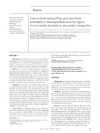Please use this identifier to cite or link to this item:
https://accedacris.ulpgc.es/jspui/handle/10553/43891
| Title: | Características demográficas, quimioprofilaxis antimalárica e inmunoprofilaxis en 6.783 viajeros internacionales atendidos en una unidad monográfica | Other Titles: | Demographic characteristics, malaria chemoprophylaxis and vaccination in 6,783 international travelers attended in a specialized unit | Authors: | Jaén-Sánchez, N. Suárez-Hormiga, L. Carranza-Rodríguez, Cristina Hernández Cabrera, Pilar Michele Pisos Álamo, Elena García-Reina, L. Pérez Arellano, José Luis |
UNESCO Clasification: | 320505 Enfermedades infecciosas | Keywords: | Viajeros internacionales Quimioprofilaxis Inmunoprofilaxis Enfermedades prevenibles |
Issue Date: | 2016 | Journal: | Revista Espanola de Quimioterapia | Abstract: | Introduccion. El objetivo fue conocer las características demográficas y la evolución temporal de los viajeros internacionales atendidos en la Unidad de Enfermedades Infecciosas yMedicina Tropical con el fin de mejorar las precauciones previas al viaje y disminuir la aparición de dichas enfermedades.
Métodos. Se realizó un estudio descriptivo retrospectivo de todos los viajeros internacionales atendidos en la UEIMT (Las Palmas de Gran Canaria) durante el periodo 1998 - 2013. Se analizaron las siguientes variables que fueron recogidas mediante un protocolo estandarizado: edad, género, fecha de la consulta, tipo de viajero, país/es de destino y medidas preventivas realizadas (quimioprofilaxis antipalúdica y vacunas). El análisis estadístico se realizó usando el paquete SPSS versión 19.0.
Resultados. Se analizaron un total de 6.783 viajeros internacionales de los cuales 52% fueron mujeres. La media de edad fue de 36 años (DT 13). El continente de destino más frecuente fue África (39%) seguido de Asia (36%) y América Latina (23%). El país de destino más habitual fue la India 13% (882), seguido de Senegal 7,5% (509) y Tailandia 6,3% (429). Las vacunas más frecuentemente recomendadas fueron, fiebre
tifoidea (82,9%) y hepatitis A (66,9%). En cuanto a la profilaxis antipalúdica, los fármacos indicados fueron atovacuonaproguanil (56,5%), mefloquina (36,7 %), En lo que respecta a los viajeros que regresan para visitar a amigos y familiares un 26,81% eran niños (0-9 años).
Conclusiones. El perfil general del viajero es un joven que con motivo vacacional elige como destino África seguido de Asia y Latinoamérica. Más del 50% de los viajeros recibieron vacunación frente a la fiebre tifoidea y a la hepatitis A. La quimioprofilaxis antipalúdica más utilizada fue atovacuona/ proguanil seguida de mefloquina. Background. The objective of this paper was to determine the demographic characteristics and the evolution of international travelers treated at the Unit of Infectious and Tropical Medicine in order to improve precautions prior to travel and, thus reduce the occurrence of these diseases. Methods. A retrospective study of all international travelers served in UEIMT (Las Palmas de Gran Canaria) during the period 1998-2013 was performed. The following variables were collected using a standardized protocol were analyzed: age, gender, date of consultation, type of traveler, countries of destination and preventive measures undertaken (malaria chemoprophylaxis and vaccines). Results. A total of 6,783 international travelers of which 52% were women were analyzed. The average age was 36 years (SD 13). The most frequent destination continent was Africa (39%) followed by Asia (36%) and Latin America (23%). The most common country of destination was India 13% (882), followed by Senegal 7.5% (509) and Thailand 6.3% (429). The most frequently recommended vaccines were typhoid fever (82.9%) and hepatitis A (66.9%). As for malaria prophylaxis, the indicated drugs were atovaquone-proguanil (56.5%), mefloquine (36.7%), in regard to travelers returning to visit relatives and friends with a 26.81% were children (0-9 years). Conclusions. The overall profile of the traveler is a young man who chooses holiday destination Africa followed by Asia and Latin America. Over 50% of travelers received vaccination against typhoid and hepatitis A. The most commonly used malaria chemoprophylaxis was atovaquone / proguanil followed by mefloquine. |
URI: | https://accedacris.ulpgc.es/handle/10553/43891 | ISSN: | 0214-3429 | Source: | Revista Espanola de Quimioterapia [ISSN 0214-3429], v. 29 (5), p. 249-254 |
| Appears in Collections: | Artículos |
SCOPUSTM
Citations
4
checked on Jun 8, 2025
WEB OF SCIENCETM
Citations
4
checked on Feb 25, 2024
Page view(s)
120
checked on Dec 30, 2023
Download(s)
49
checked on Dec 30, 2023
Google ScholarTM
Check
Share
Export metadata
Items in accedaCRIS are protected by copyright, with all rights reserved, unless otherwise indicated.
